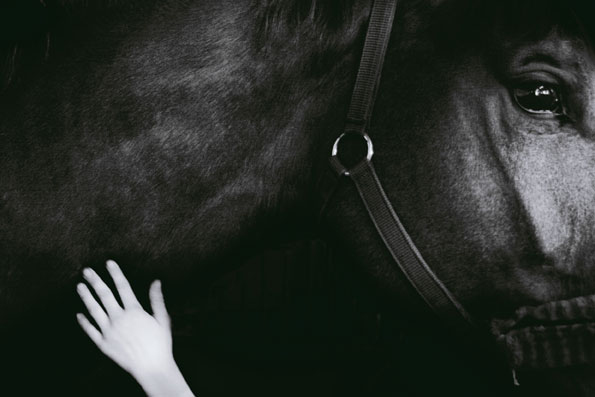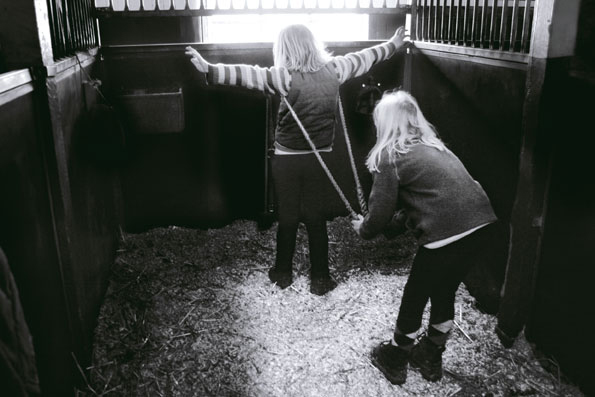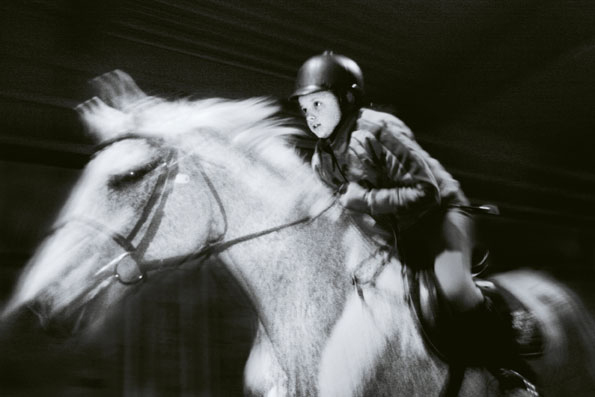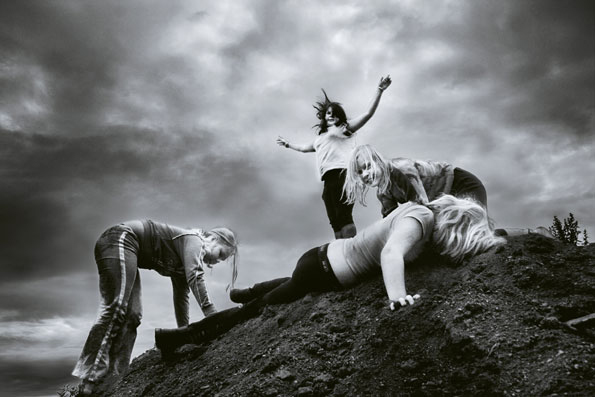Stallflickor (Stablegirl) by Theresia Brakenhielm
Review by Susan Bolling

What to expect
Stallflickor, by Theresia Brakenhielm, is a collection of black and white photographs that collectively capture the spirit of the stable girl and her relationship to her horse and her companions. Following the photographs is several pages of copy by Moa Matthis, known for her essays about “the stable girl” from a feministic point of view.
“I rang her up and asked her if she would like to have a look at my images and perhaps be inspired to write an essay for my book,” writes Brakenhielm. “Moa loved my images, and I hired her to write for my book.”
For the sake of tactile perspective, the book measures roughly 8 x 10 inches and is hardbound in a red linen cover, stamped in black ink with a simple horse shoe graphic. Printed on heavy, matte paper, the photographs are somewhat high-contrast with a significant amount of grain – both of which are appropriate qualities given the subject matter.

Context
Given my inability to speak Swedish, my understanding of Matthis’ writing is limited to what was provided by Brakenhielm in a written summary of the text. Brakenhielm says of Matthis:
She insisted that her text was not about to nag about how strong and cool the stable girls were. Her emphasis became on including the young girls as administrators of the horses’ heritage. Just as natural as the Mongols, Native Americans, the cavalry, the old farmers and so on. So the text is basically a chronological story about the history of the Horse, starting with 30,000 year old carvings and ending with the stable girl.
The retro perspective that Moa has written gives us a good historical insight of our cultural relation with horses. At the end Moa calls attention to the opportunity given to the stable girls to get away from the traditional given role as women with which they have been burdened. Without being patronizing, she describes the stable being a place where young girls and women are expected to be goal oriented, passionate, focused and hard working.
Each photograph in the book captures a moment in or around the stable during which time appears to stand still. Whether it’s one young girl nuzzling the face of her hose (p.p 46-47) or a gathering of girls on a hill top, relishing in their freedom (p.p. 25-26), Brakenhielm is there to document the outward presentation of their thoughts and feelings.
One photograph in particular shows a young girl in the saddle, leaning forward and resting her cheek on the horse’s neck (p. 58) – her expression is thoughtful, but also secure and it’s clear she feels safe and at home. As are all of the photos, the image is exposed in a way that the highlights tell the story and the shadows provide just enough detail to communicate the typical dark and musty stable environment. Brakenhielm allows everything about her surroundings – the light, or lack thereof, the subject and her perceived intentions – to determine the appropriate exposure and print for the image.

Review
Brakenhielm has an uncanny ability to communicate an intimate story line via a series of photographs. Horses have long been a symbol of strength and independence for men and women alike, however, whereas a man might lean on his horse for task, a woman seems to lean on her horse for empowerment and empathy. They are a natural pair – both lean, elegant creatures, frequently underestimated for their agility and endurance, as well as a keen intuition and sharp awareness of their surroundings.
A girl and her horse adds yet another dimension – the feeling of invincibility fueled by a free spirit not yet tarnished with the restrictions of society’s expectations. In her youth, the girl also looks to her horse for reassurance and strength – a loyal comrade in the battle, and a shared gaze that exudes both confidence and determination.
I understood the story Brakenhielm is telling because I’ve seen it, and albeit many years ago, I lived it. My home now is Roanoke Island, North Carolina, and on the south end is the fishing village of Wanchese. Here the girls ride bareback and barefoot on their ponies down the half-dozen roads - sometimes in clusters of three of four, and sometimes alone, galloping as far as there is room, hair blowing in the wind and a smile that says she intends to leave her worries as far behind as she can ride that evening.
It’s comforting to know this relationship of kindred spirits is alive half way around the world. In addition to professional presentation, Brakenhielm is to be commended for her exceptional celebration and genuine interpretation of this inspiring phenomenon.
Stallflickor is a must-read for any photographer aspiring to deliver a story beyond a mere series of events to include the underlying motive of their subject and its relationship to its environment.
For more about Theresia Brakenhielm visit her website at: theresiaviska.se
For more about Susan Bolling visit her website at: susanbolling.com




